2023 Non-Toxic Sofa Brands Guide
Written by:
Maia James
05/12/2023

Updated: 01/02/2024
Looking for a different guide? Browse them all HERE.
Welcome to the latest version of our complete guide to finding eco-friendly, non-toxic sofa brands.
I was once a guest on The Dr. Oz Show with a toxicologist from Yale. Although we were discussing phthalates in macaroni and cheese for this particular episode, I asked him during a break what he was MOST worried about in terms of toxins in the home. To my surprise, it wasn’t plastics or fragrances, but instead household dust, largely due to furniture whose toxic contents constantly shed.
Since sofas are often among the largest pieces of furniture we have in our homes, and ones on which we spend a lot of time, this seems like an important item to get right.
I wrote this post for those of you ready to invest in a truly safe, non-toxic sofa (or upholstered chair). We’ve done the research for you, and this post covers all the details about our favorite non-toxic sofa brands, plus other brands you have asked about–including popular big box upholstered furniture stores.
Bottom Line: The 6 Safest Non-Toxic Sofa Brands
If you’re looking for the best non-toxic sofa brands, these six are the best of the best. You’ll read all about each of them further down, but if you want to just buy, please make note of some exclusive discounts in the list below.
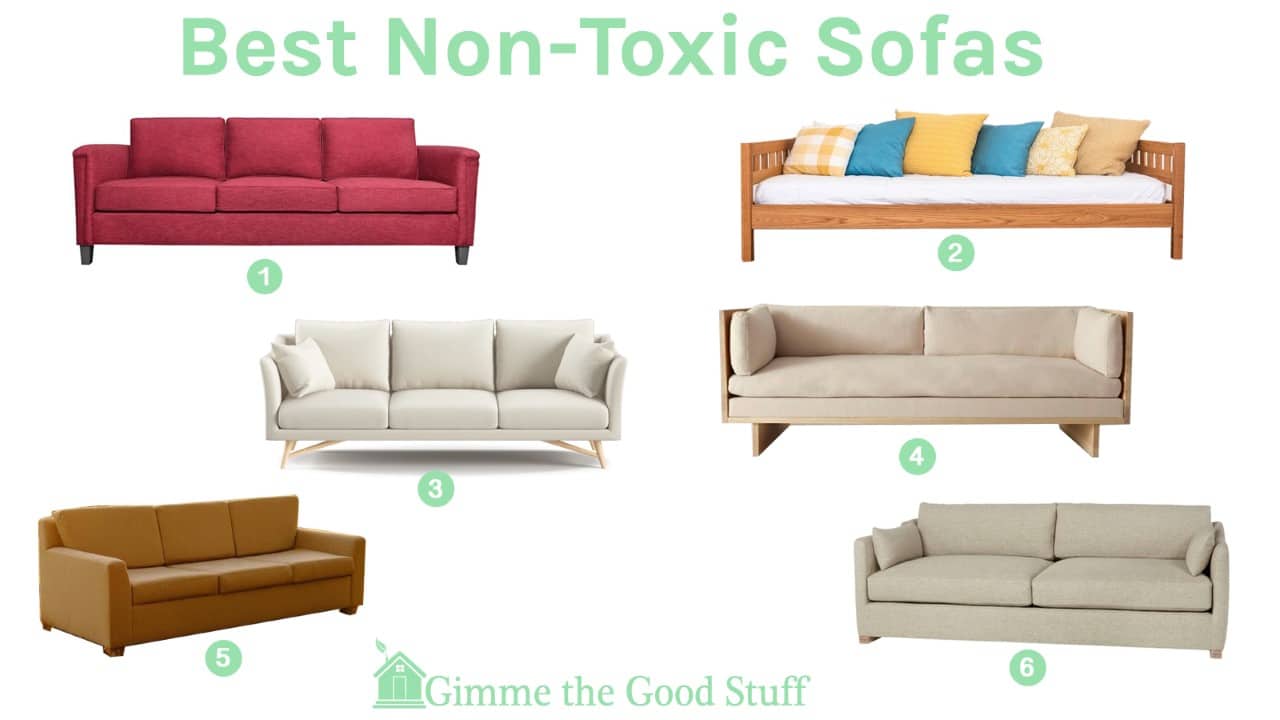
- EcoBalanza – 10% off for our readers. Email us to order.
- CleanSleep – Thank you for supporting our store 🙂
- Medley – 5% off with code GIMME5
- Kalon Studios – 7% off for our readers. Email us to order.
- Savvy Rest
- Cisco – 15% off for our readers. Email us to order.
Non-Toxic Sofa Materials
When you’re evaluating upholstered furniture brands, here are some things to look for:
- Cushions. The most sustainable materials for cushions and padding are natural latex, cotton, down, and wool. Polyurethane foam isn’t Good Stuff, strictly speaking, but we are okay with it in sofas. You’ll want to avoid cushions with fabrics that have been sprayed with stain-resistant treatments, as these usually contain PFAS.
- Frame. Opt for solid wood construction instead of composite wood products. You can learn more about what to look for in wooden furniture, including sofa frames, in this post.
- Finishes. Look for sofas made with glues, stains, and varnishes that are zero or low-VOC.
- Certifications. The Global Organic Textile Standard (GOTS) and the Global Organic Latex Standard (GOLS) certifications ensure that the fabrics and latex used in your sofa meet the strictest standards for health and sustainability. Poly-based foams should have CertiPUR certification, which at least limits the VOCs emitted. GreenGuard Gold certification is easier to achieve than GOTS or GOLS, but still better than nothing! You can learn more about these certifications in our mattress guide.
Flame Retardants in Furniture
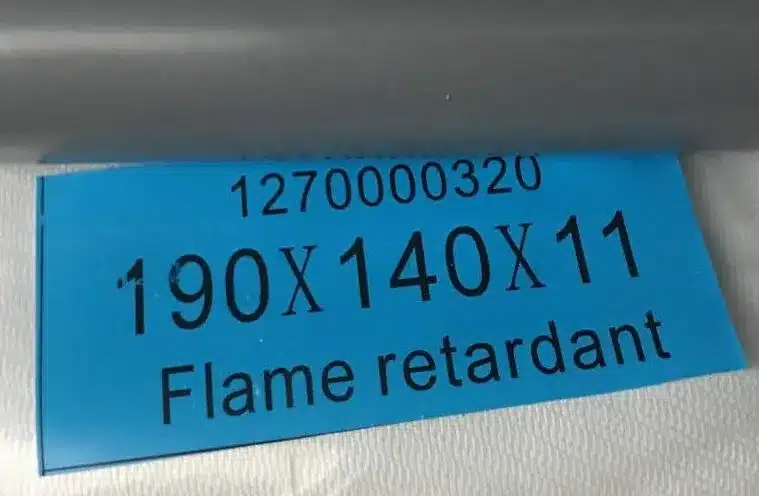
You’ve probably read–on this website and elsewhere–that your sofa is bad for your health in large part because of the flame retardant chemicals it may contain. Indeed, if your sofa was manufactured before 2014, it almost certainly contains one of the following flame retardants:
- Polybrominated diphenyl ethers (PBDEs) are found in mattresses, electronics, and cars, in addition to the foam of sofas. PBDEs are associated with hormone disruption and neurodevelopmental delays, including lowered IQ . The European Union has banned the use of PBDEs in electronic devices. Studies show that children in the United States have higher levels of PBDEs than adults do. Oh, and here’s the kicker: they don’t even work very well at stopping fires.
- Firemaster 550 is made with bis(2-ethylhexyl) tetrabromophthalate (TBPH). Yes, you saw that word in there: phthalate. TBPH is nearly idential to DEHP, the phthalate banned in children’s products due to evidence of carcinogenicity and developmental toxicity.
- Chlorinated tris is the chemical that was removed from children’s pajamas in the 1970s because it was shown to cause cancer.
Good News on Flame Retardants!
Things changed for the better nine years ago. The flammability standards enacted in 2014 can be met WITHOUT the use of the toxic chemicals I just described! To be clear–the law does not BAN the use of the chemicals; it just renders them unnecessary. Look for the TB117-2013 label on sofas and pillows, which suggests that the item meets the standards without fire retardants.
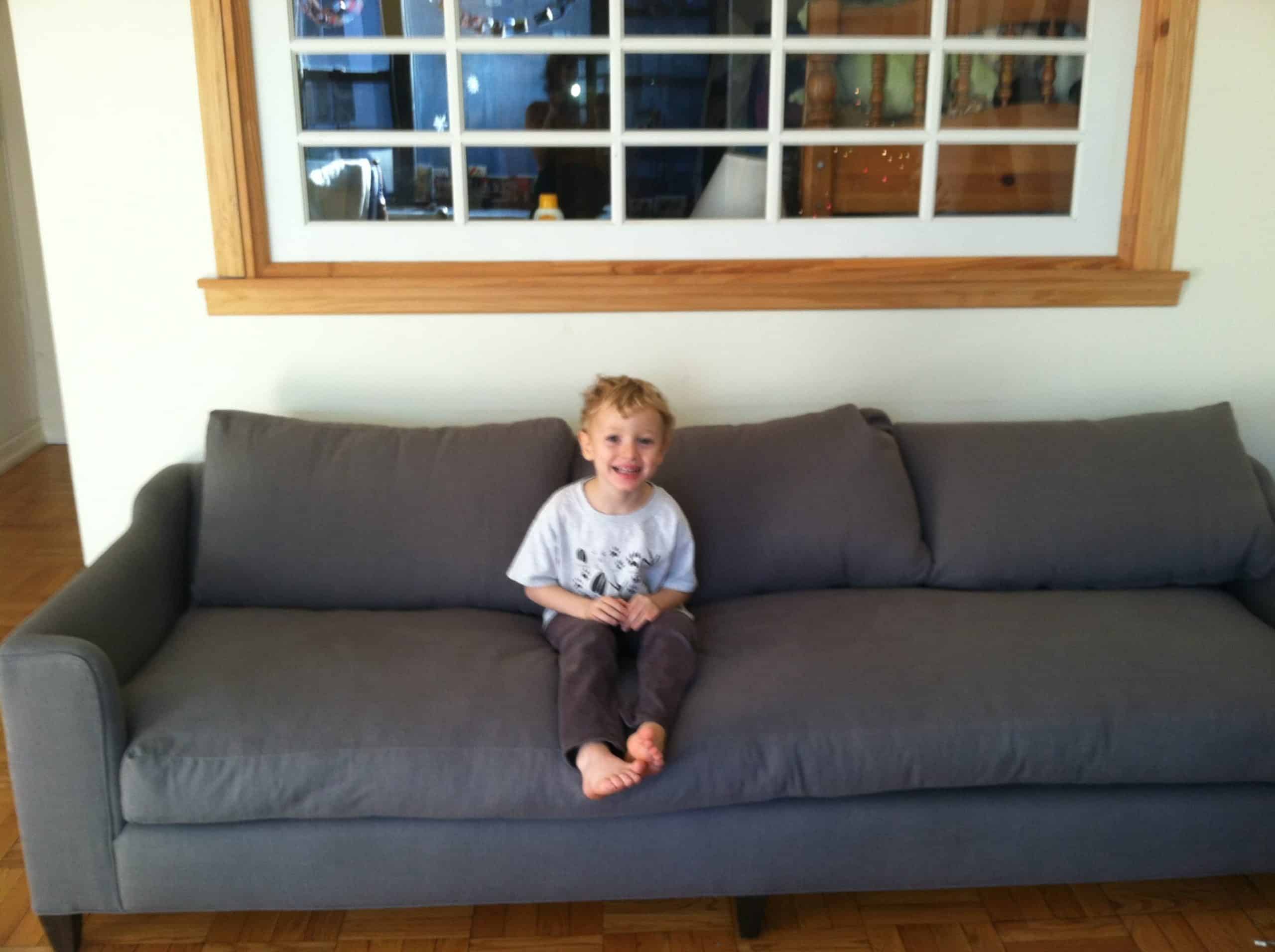
How to Reduce Your Exposure to Flame Retardants
This guide is intended to help you select the safest sofa or upholstered chairs. However, if you’re not yet ready to plunk down thousands, here are some other steps to limit your exposure to older furniture in your home.
- Keep foam enclosed. Be sure to mend any rips in your sofa or chairs that might allow chemically-treated foam to be exposed, and don’t remove cushion casings to launder.
- Upgrade your mattresses. If replacing your own mattress is out of the question, consider upgrading just the mattresses for your children. Many of my clients think their crib mattresses are okay if they are old because they have “already off-gassed.” In fact, as the foam degrades, more PBDEs and other chemicals may be released. Get help choosing a truly non-toxic mattress with our Safe Mattress Guide.
- Ditch your broom. Flame retardants accumulate in household dust, and sweeping puts plumes into the air. Instead, use a vacuum or wet mop to banish dirt and toxins. Invest in a HEPA-sealed vacuum that really traps toxins.
- Invest in a robust air filter. We like (and own) Austin Air filters, which employ HEPA, activated carbon, and zeolite, a mineral with superior ability to trap toxic gases and odors such as formaldehyde, ammonias, and carbon monoxide.
- Eat more plants. Unfortunately, even though these chemicals are being phased out, they will continue to persist in our environment for years. The number one food source of PBDEs is poultry fat. The lowest levels of a variety of toxins–including flame retardants–are found in plant-based foods, so if you substitute beans for chicken a couple of times a week, you’ll reduce your exposure.
Looking to protect your sofa without toxins or PFAs?
Looking to protect your furniture without toxins? We are excited to introduce Proof+, a collection of fabric protectorrsthat are completely natural and free of all PFAs. Simply spray this treatment on your favorite furniture or carpet and watch it magically repel liquids and help protect valuable fabric materials from absorbing stains.
What Other Toxins Are in Sofas?
Unfortunately, flame retardants aren’t the only problem with upholstered furniture.
The glues and finishes on wooden legs can contain formaldehyde. Even without a chemical bath, polyurethane foam is a petroleum-by product that releases VOCs.
Anything that is wrinkle or stain-resistant from a treatment like Scotchguard should be avoided. Back in the day it Scotchguard contained a noxious chemical called PFOS–which is not only terrible for the environment but also linked to cancer, hormone disruption, and immune system dysfunction. Scotchguard agreed to phase out PFOS and has replaced it with PFBS. Overall, PFBS seems safer, as it has a shorter half-life and accumulates in our bodies at a slower pace. I remain skeptical as safety studies are still lacking.
Leather is another sofas material that is frustratingly problematic. Leather itself is not inherently toxic, but the tanning process used to turn animal hides into leather can involve the use of chromium, formaldehyde, and various solvents. Additionally, some leather products may be treated with flame retardants or stain-resistant coatings or phthalates. Chrome-free leather is acceptable, in my opinion, and better yet is leather that specifies that it is chrome-free and vegetable dyed. The two brands I know of that make this kind of leather furniture are Medley and EcoBalanza, both of which you can read about below.
Good Stuff
Carolina Morning
Carolina Morning is a super clean yoga-prop brand that we carry in our store. And you can configure their futons and frames into a non-toxic sofa, like the one pictured here.
The wood used by Carolina Morning is Appalachian poplar, which is finished with a whey-based finish.
The cushions are kapok-filled with GOTS certified organic cotton canvas covers, available in a range of colors. Everything made by Carolina Morning is free of PFAS and fire retardants.
How to Get a Carolina Morning Sofa: Email us to order, or give us a call at 717-413-8182. You’ll pay $2,900 for a full sofa configuration.
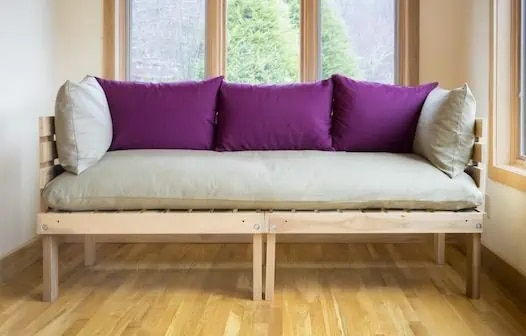
Cisco Brothers
Cisco was the first Good Stuff sofa we ever bought in 2013, and we still have it (now featuring a few marker streaks) in our den.
When I bought my Cisco sofa, not all of their models were free of flame retardants. I had to pay more for the “Inside Green” option, which was also filled with organic down and natural latex instead of polyurethane foam.
Now, all Cisco products are free of flame retardants and formaldehyde glue. You can still choose Inside Green if you want down and latex for your fill.
All Cisco wood is certified by the Forestry Stewardship Council and treated with only low-VOCs finishes.
How to Get a Cisco Sofa: Cisco extended me a designer discount on my sofa, and I’m happy to pass 15% off for our readers. Email us for a quote or to order. You’ll pay around $5,000 and $8,000 for most sofas with the Inside Green option from Cisco, before this discount.
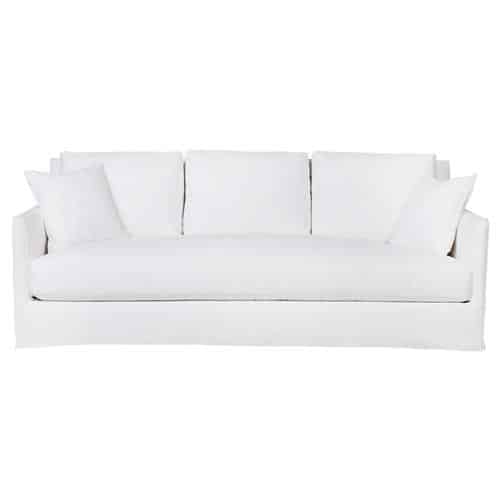
EcoBalanza
EcoBalanza’s upholstered furniture is all custom and handmade in Seattle.
These sofas (or loveseats) are composed of only the safest materials, including organic wool and cotton, kapok, down feathers, and GOLS-certified latex. The wooden components are made of solid wood.
EcoBalanza furniture is free of flame retardants and PFAS. All of their adhesives and stains are zero or low-VOC, and EcoBalanza can also leave the wood unfinished.
If you’re looking for a leather sofa, EcoBalanza uses vegetable-tanned leather that is free of all heavy metals.
How to Get an EcoBalanza Sofa: We can offer 10% off EcoBalanaza furniture. . After browsing their site and deciding what you want, you can email us to order. This is a higher end line, so you should expect to pay more than $5,000 for these sofas.
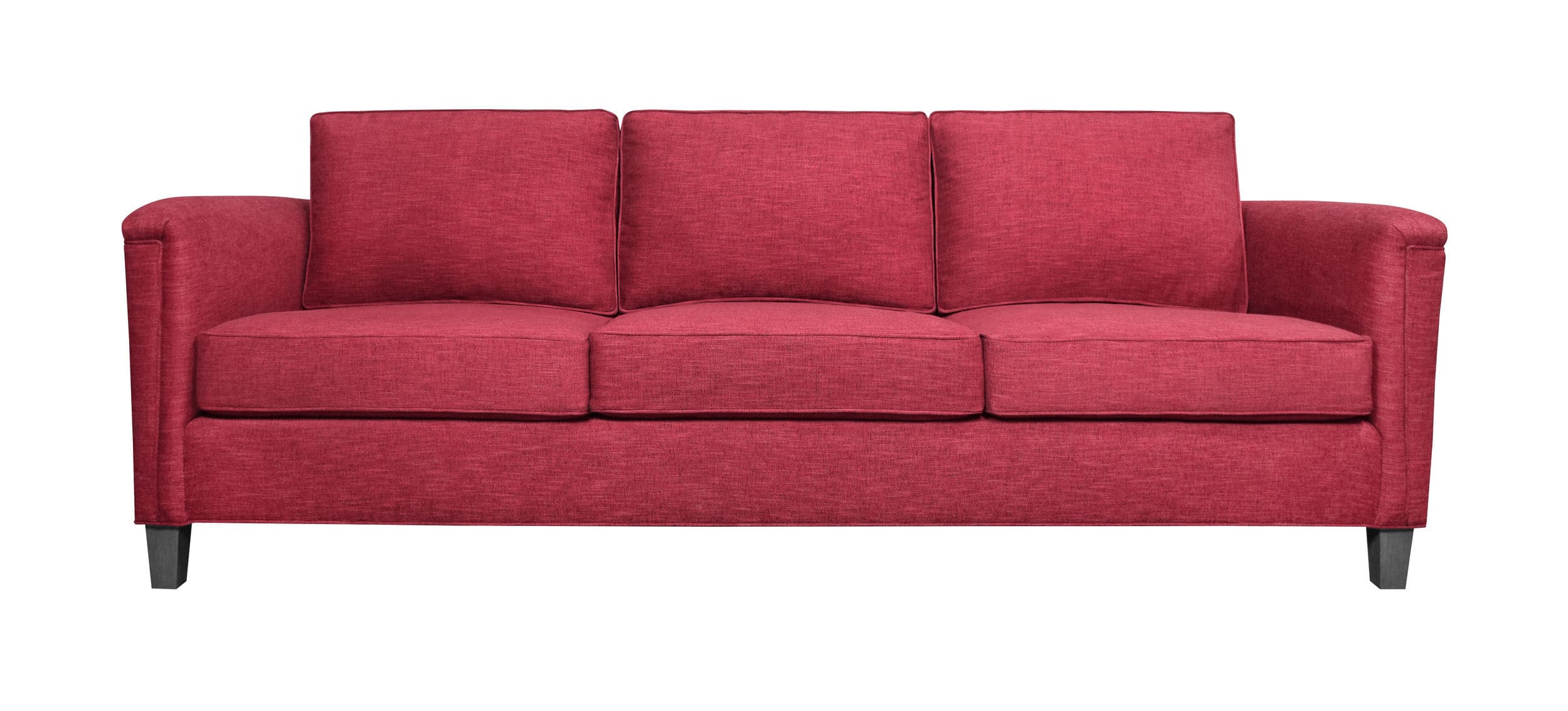
Futon Shop
The Futon Shop obviously makes futons, but they also make upholstered seating, including easy chairs, sofas, loveseats, and sectionals.
These sofas check all of the boxes we look for when identifiying non-toxic sofas brands. They use solid pine for frames and legs, and you can choose from latex, organic wool, or poly-based foam for the cushion fill.
Other materials in these sofas include coconut coir, organic cotton, and linen. Nothing is treated with flame retardants or PFAS.
How to Get a Futon Shop Sofa: You can order these sofas from Futon Shop’s website. They are one of the most affordable non-toxic sofa brands, with prices starting at $1,800.
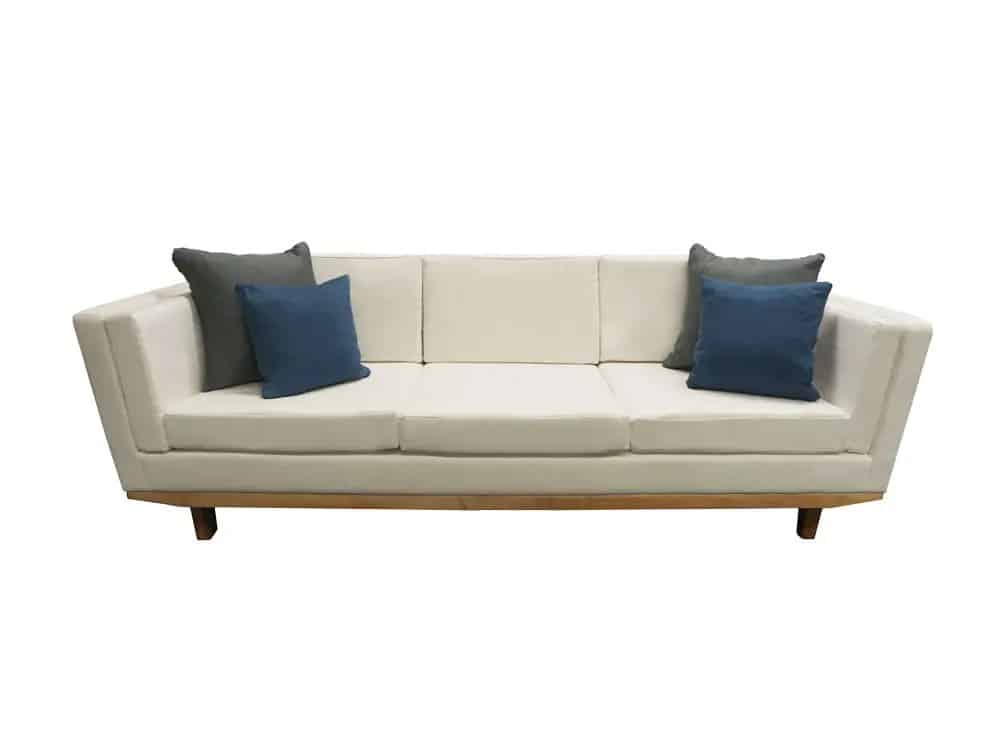
Kalon Studios
Kalon makes the most beautiful solid wood pieces, which you can also read about in our Safe Wooden Furniture Guide. They make several sofas as well, including this stunning one (the pink is so pretty!) and this one that I am seriously coveting. Their most popular sofa is the Rugosa, which comes in a range of gorgeous fabrics.
Why we love Kalon:
- Wood is sustainably sourced, solid hardwood, and finished with just organic plant-based oil.
- Sofa fill is 100% feathers.
- EDC free (free of all endocrine disrupting chemicals).
- Fabric is linen and mohair.
How to Get a Kalon Sofa: If you’d like to order through our trade program with Kalon, you’ll receive a 7% discount on everything on their site, including the Rugosa sofa, which normally retails for about $8,900. To begin the process of placing an order this way, email us here.
Medley
I own many pieces of Medley furniture, all of which I love for being both modern and comfortable.
Here’s what else I love about Medley:
- Medley uses “green” sources of wood, including FSC-certified maple and walnut.
- Natural latex, which is resistant to bacteria, mildew, and mold, is used as a filler in place of polyurethane foam, provided you select this option. Because of our budget, we choice the poly foam option, which is free of flame retardants.
- Medley has new ways of building their sofas, including needled wool on the frames and fluffy wool fiber for the back pillows. This is truly a unique process (learn more here).
- The feather/down fill option consists of 100% feathers and down, both of which are thoroughly cleaned (with non-toxic cleansers) before being used.
- You can opt for recycled, 100% natural, and even organic fabrics on your Medley sofa by selecting that filter when choosing your upholstery.
- The glues used by Medley are water-based, which make them much less toxic (and less flammable) than standard solvent-based adhesives.
- Similarly, the stains and finished used on wood pieces contain no solvents, preservatives, or biocides, and instead are treated with plant oils.
How to Get a Medley Sofa: Medley sofas can be ordered on their website, and they’ve done the unimaginable and actually lohttps://medley.sjv.io/VmBO06wered their prices recently! Sofas start at $2,400. Even better, Medley has generously offered Gimme the Good Stuff readers 5% off of orders. Please use code GOODSTUFF5 when ordering.
Savvy Rest
Constructed in their Central Virginia production house, Savvy Rest organic sofas, loveseats, and armchairs are made with quality, safety, and longevity in mind. In all Savvy Rest furniture, you’ll find:
- Natural Talalay latex foam
- Certified organic fabrics (cotton, hemp, and a cotton/hemp blend)
- Sustainably-sourced maple hardwood
- Organic wool batting used as a natural flame barrier
- Zero-VOC linseed oil and AFM Safecoat stains
In addition, Savvy Rest furniture avoids all forms of formaldehyde glues, cardboard, metal coils, particle board, plywood, veneer, polyester, polypropylene, polyurethane, toxic stains, dacron batting, feathers, or down.
How to Get Savvy Rest: You can order a sofa, chair, or loveseat from Savvy’s website. Sofa prices begin at $3,695.
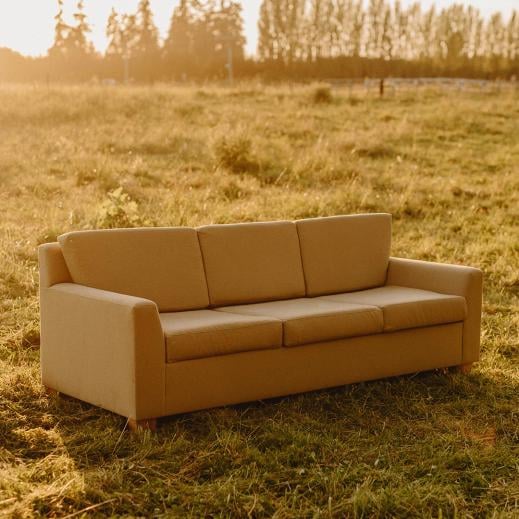
If you’re enjoying this guide, sign up for our Newsletter to be alerted when we publish or update our Safe Product Guides.
Okay Stuff
Many conventional brands have removed flame retardants from their furniture. The sofas from the following brands will lack the very bad chemicals listed above, but may contain other questionable materials. This includes polyurethane foams, stain or wrinkle treatments, and formaldehyde-containing adhesives.
Crate & Barrel
Crate has eliminated flame retardants from their upholstered furniture. It is still not clear to me whether or not all Crate & Barrel items are entirely free of PFAS, though. The wooden parts of Crate’s sofas are also mostly particleboard.
Still, a number of these sofas have GreenGuard and FSC certification. Crate & Barrel makes it easy to see which pieces have these certifications by placing the icons on each sofa collection when you browse. You can find a sofa with both GreenGuard and FSC for as low as $1,700. (I like the Gather collection, which has both certifications and is pictured here.)

Burrow
Burrow sofas are stain resistant without the use of PFAS, which is awesome. They do you plywood rather than all solid wood, but you can choose metals legs. Burrow does not have any certifications, but their foam is CertiPUR-US certified, which ensures that the sofa is free of flame retardants.
You can get a Burrow sofa for less than $1,500, like the Field, pictured here.
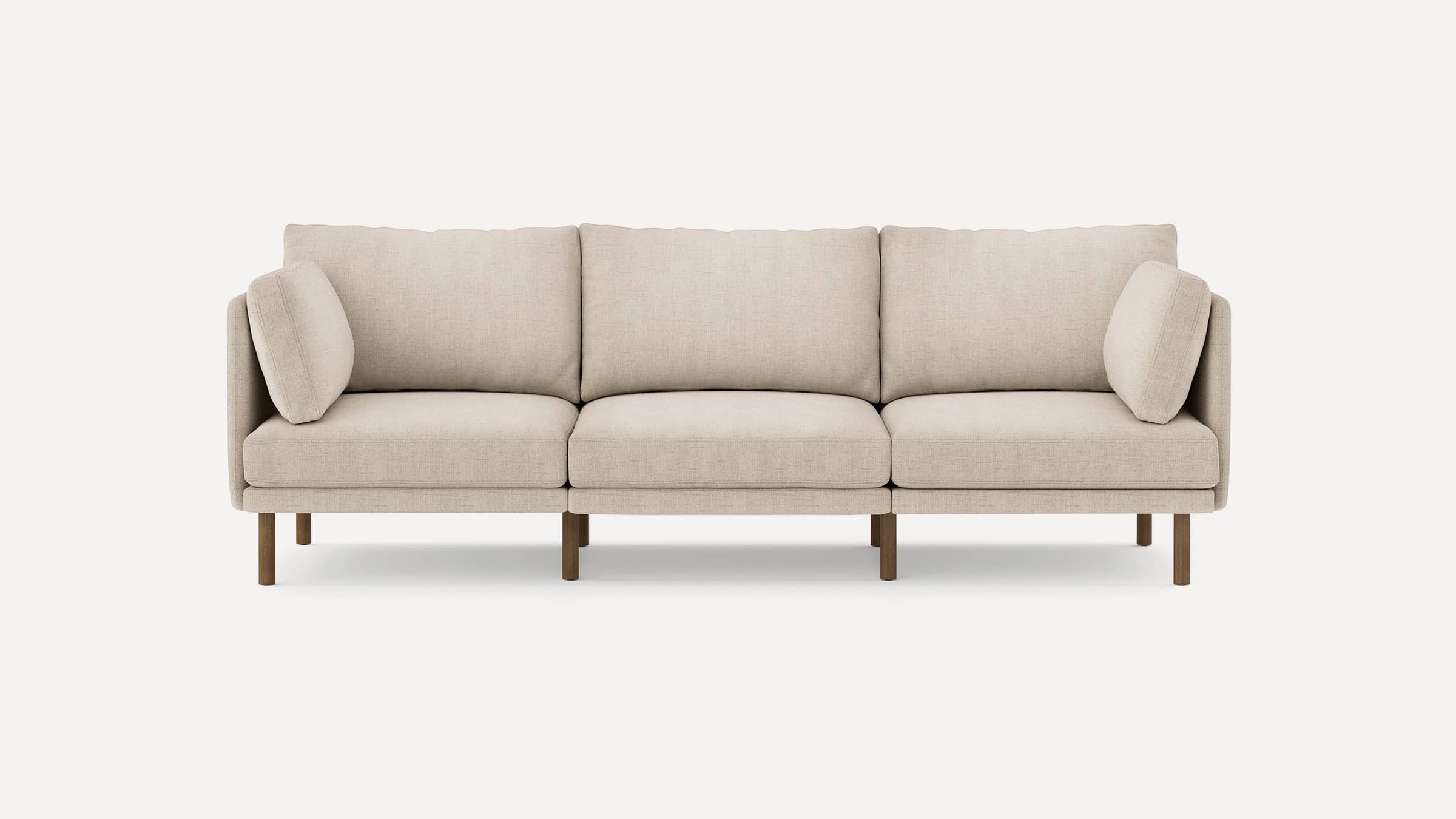
IKEA
The only info I can get out of Ikea is that “some of our upholstered furniture contain flame retardant chemicals around the zippers.” Ikea sofas don’t contain PFAS, but do contain particleboard.
Lulu & Georgia
This brand makes beautiful furniture, but there is nothing especially eco-friendly or non-toxic about most of it, with a few exceptions. The Ansley, Bex, Cami, and Afia (pictured below) are low-emission and/or GreenGuard Gold certified.
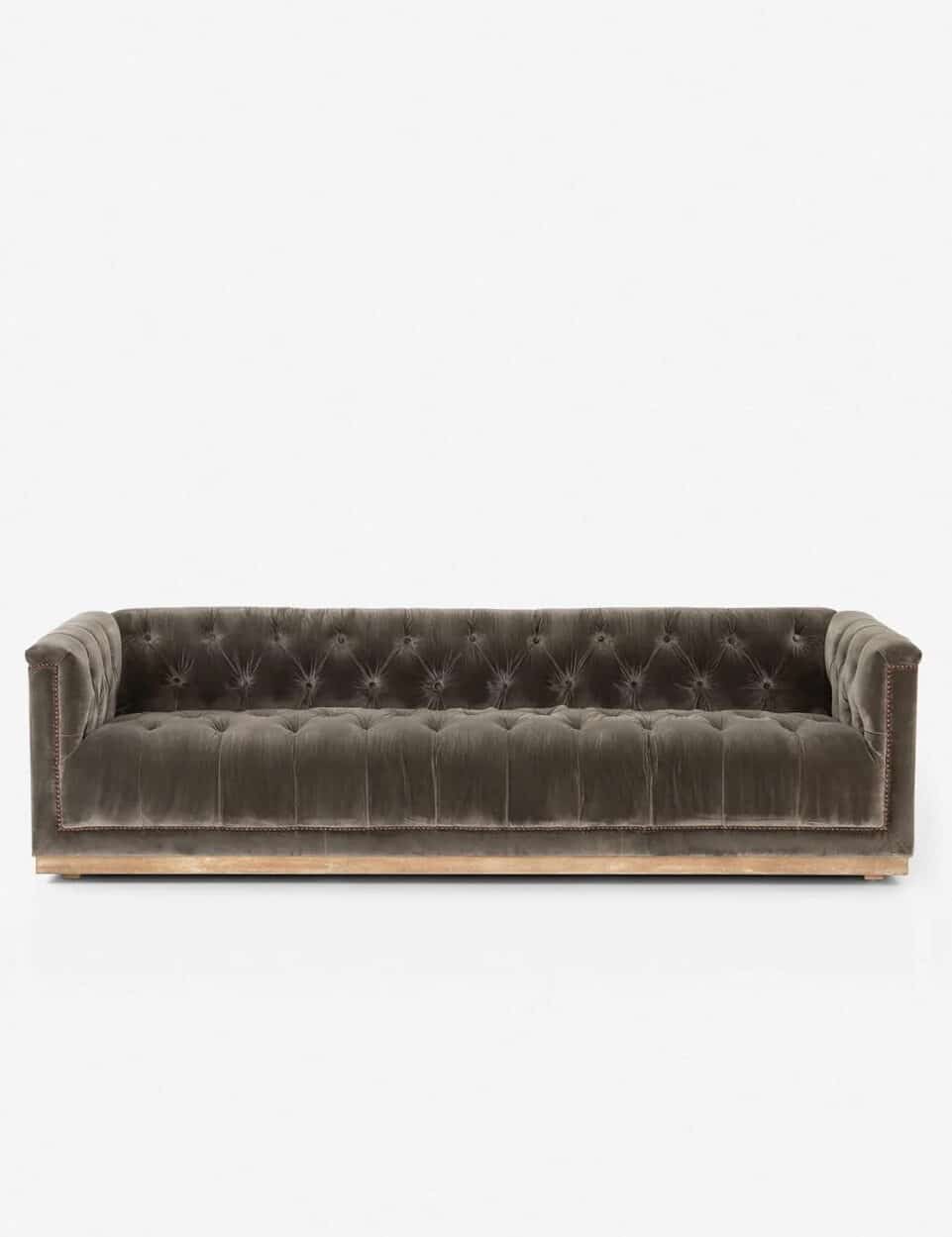
Nugget
Nugget play sofas are mostly polyurethane foam. In other words, it’s not made of natural materials. That said, they are GreenGuard Gold certified. This is the least impressive certification, but still something!
Pottery Barn
PB actually has a green line now, although even the “down” fill is 50% polyester fiber. Still, this line includes solid wood and the option of GOTS certified organic cotton, which means they’ll be free of PFAS. They also have a line of GreenGuard Gold certified items, including the Paxton glider (pictured here) and the Avalon upholstered bed.
Room & Board
Room & Board does have GreenGold certification on some of their sofas, but it seems that not everything is PFAS free so proceed with caution.
West Elm
West Elm doesn’t treat their furniture with flame retardants. Some West Elm upholstered furniture has GreenGuard Gold certified, including their Hargrove line, the Carlo chair (pictured here), and the Midcentury daybed.
Are there other potentially non-toxic sofa brands you want to know about? Comment below.
If you’d like to see all of the upholstered furniture in my own home, I give you a little tour here:
View this post on Instagram
Stay sane,


Maia, Founder & CEO
Note: This article contains affiliate links or sponsored content, which means that if you make a purchase, we may earn a commission. We only recommend products that meet our strict standards for non-toxicity and that we use (or want to use!) ourselves. Thank you so much for supporting the brands that make Good Stuff!
Enjoying this guide?
Join 60K families who rely on our free guides on everything from milk to mattresses! Sign up to get $5 off your first order, access to our ultimate Clean Products Cheat Sheet, and ongoing exclusive access to coupon codes and promotions. Our weekly newsletter is filled with well researched tips and tricks to live a toxin-free lifestyle.
Related Posts
Start Here: 5 Crucial Steps to Decrease Toxins in Your Home
Are Serta Mattresses Toxic?
What Is the Best Non-Toxic Cutting Board?
2023 Safe Non-Toxic Cookware Guide
-
What do you think of Lee Industries furniture?
-
So far it’s pretty good stuff. Very educating…. Keep up the wonderful work guy’s
-
-
Hi,
What are your thoughts on Greenguard gold certified Pottery barn furniture like bookshelves? They are mixture of solid wood and MDF but carry this certification. Are they non-toxic or is is green washing?
-
Hi SN, Thanks for the question. The fact that these Pottery Barn products use MDF but also have a Greenguard Gold certification tells you much of what you need to know about Greenguard Certification. While Greenguard is better than no certifications, it is not what we want to see. We will soon be publishing our Wood Furniture Guide. It will address much of this subject. Keep an eye open for it on our site. Thanks
-
-
Hello…I am looking for a recliner chair that does not contain latex, polyurethane or polyester as I am allergic to all three. Does anyone know where I can find this type of recliner ?
-
Do you have any information on safe (non-toxic) fabric at LaZboy? I just ordered a recliner with iClean fabric and afterwards found out it’s not safe. I need to call to change the fabric but wanted to get some info on a safe fabric (not leather).
-
Hello,
Thanks for this article! I am looking at Medely and Cisco right now but I don’t know what fabric to use. I have three little kids so durability is important but I also am concerned about synthetics and treated fabrics. What fabrics did you go with and how have they held up on both couches over time?
-
Thanks for the info, good thoughts. But do you know of any ideas for normal people who can’t spend 5,000 on a sofa?
-
Considerable article, We at Property Hunters shifted this service to a level much higher than the broker concept. you can see more details like this article Good location in pearl qatar
-
the futon shop is a really awesome natural furniture online store. You can upgrade to make anything they sell organic and everything is chemical free no matter what. They are way more affordable than any other non toxic brand I’ve looked into.
-
I ordered a Futon Shop non toxic sofa and it was so affordable. Bummed though because after owning it for under a year the seat cushion on the bottom is wearing unevenly.
-
I have a futon shop all organic sofa and while affordable, it’s the most god awful uncomfortable thing I can ever imagine sitting in. $3700 (it seats 4-5 comfortably it’s large) and we absolutely hate it. Even tried a different “fill” from them and still can’t stand it 🙁 came here looking for a sofa we can actually try in person next time, isn’t a fortune, and is truly non toxic. But sadly it seems like you can only get two of those things in a sofa…Maia please update this guide soon!! We need more options 🙁
-
-
Hi Michaela! I’m looking into Futon Shop now. Which model did you get, and has it held up well? Comfortable enough to be main family TV-viewing spot?? Thanks so much 🙂
-
-
Maia, nice article.
I have struggled for hours online to find even one non-toxic recliner sofa. I looked a little at the American Leather company, but not sure that’s a safe way to go.
Have you seen any companies that make non-toxic recliners (preferably recliner sofas) or any suggestions for best company for this?
thanks!
John
-
Please update your guide- The Futon Shop has many clean sofa options at affordable prices. Other affordable retailers like Ashley Furniture and Rooms to Go state that they removed FR years ago. Thanks for all the you do! 🙂
-
thanks so much for all this detailed info! Any idea if Pottery Barn’s current offerings of “green guard” and “green leaf” fabrics (including organic fabrics) are reliably non toxic?
-
Wondering the same…
-
-
I was looking for a response about Lazy Boy. The agent pulled up the furniture and showed that is was flame retardant safe per CA standards. Can someone verify if they know otherwise? Thanks
-
Just ordered a DaVinci recliner it has the TB 117-2013 label. Great price too on Amazon.
-
hi,
i was wondering about joybird sofas. i found this information on their site.
“None of our foam or fabrics contain PBDE (flame retardants) and they are certified to be free of toxic gases. The current suppliers we work with test our materials to ensure they are free of any toxic substances and we will do our best to continue to partner with companies that can meet those standards.”
“You’ll be happy to know that Joybird products do not contain any harsh chemicals, and our fabrics and foams do not contain any flame retardants.”
thank you for any help you can provide.
-
Happy Thanksgiving week! Any new recommendations for all this? Or anybody else see some Black Friday deals? Thanks!
-
I know your Cisco Brothers couch is older, but any clue what type of fabric they used? There are two greys we are looking at a linen (but we are worried it’s too thin) and an organic cotton fabric that has light hashmarks. Wondering what yours was since it held up so well!
Thank you! -
I, too, wonder about Ethan Allen and Lazy Boy. Are you still responding?
-
Ethen Allen has horrible off–gassing. I just received a chair from them and have had it in a room with the windows open 24/7 for over a month. It still smells.
-
Hi, How is your ethan allen chair now? They say they use CertiPur-US® certified foams. Not sure if that is better … but one of the few affordable furniture companies I have seen that seem to choose something better? What was your decision in buying Ethan allen
-
-
-
Wondering if anyone has any information & experience with Lazy Boy ?
I have been told they do not have flame retardant, but I am wondering with other chemicals, and also for MCS? So many post about new sofas having strong odors.
Also wondering about Ethan Allen? -
I wanted to share my experience with Stem. I purchased the Blumen Chaise and it was delivered two weeks ago. It seems they have changed warehouses and perhaps this is affecting the quality. I spent over $6K for the latex and wool option and I bought an organic cotton velvet. They upholstered the velvet with the nap in every different direction, which really has an effect on the color. It looks like patchwork! In addition, they completely forgot to encase the latex cushions in a zippered cloth (cotton muslin), so the upholstery fabric is touching the latex/wool directly. They also forgot to add latex to the back seat cushions and this is only what I’m able to see . . . The arms of the couch are not well cushioned. I can feel the wood in the arms. I would seriously discourage or have people sit on these couches before investing $6K.
It maybe that there couches were once very good quality and perhaps the change in warehouse has affected the quality, OR I just got the one-off dud.
-
Thank you for the helpful information about sofa. For professional sofa services visit http://www.sofakingdubai.com/sofa-furniture-refurbishing
-
Hi! Loved your article. I am a recent college graduate on a tight budget. Any ideas about couches that are under/around $1,000? I was also wondering what you thought about the “LoveSac” brand. I have heard they are quite good. Thank you!
-
Hi Maia! I know this is an older post, but I wanted to mention that a more affordable option has come on the market. The futon shop is now making a non-toxic sofa and they’re about $1600 each! I am planning to buy one. They also make a loveseat. Have you looked into them? I also know that Ashley Furniture, while certainly not non-toxic, is no longer using flame retardants in their sofas. Thanks!
-
Hi,
Do you know if Lay Z Boy furniture (recliners) are considered safe?Thanks,
Liane -
Sofas come in a multitude of variations. Whether you’re basing your choice on their finish color, style, upholstery color, or sofa type, you can be confident in finding numerous options; in fact, it’s natural to be overwhelmed with all the choices.
-
My very cute inexpensive cloth-like linen burlappish upholstered, trendy sofa, was delivered about six weeks ago (had it on lay-away for a year) I’m sure it was made in China. Shortly after, I bought two very soft throws from Walmart to cover the sofa, which I washed immediately before putting them on the sofa. I’m sensitive to chemicals and started getting eczema on my left arm on my wrist, which spread up my arm and onto my left upper back and is getting worse on my back. Could it be from the soft throw covers of the sofa? I’m not in a financial position to get rid of a brand new sofa. Any suggestions? I’ve now been looking at U.S. made sofas. I’m buying a new bed, too, which will come from a U.S. manufacturer. When transporting furniture (beds and sofas), do U.S. manufacturers also use DMF and silica packets? I’m worried about my dog’s bed, too. It’s ridiculous that we’re all being poisoned. How do we avoid these allergic reactions, especially for young children? I would so appreciate any information. Thanks!!!
-
Not understanding why you recommend Stem. They use poly foam. Which configuration did you buy??? A latex frame + cushions on the Blumen is a 3K upsell making it a six thousand dollar couch. I would rather make my own.
-
Hi there!
My husband works at Wayfair, so we’d like to try and take advantage of his employee discount; however, I’m concerned about their couches being mass-produced and full of chemicals. What have you learned about this company? Any couches in particular that you know of that are featured as non-toxic through this company?
Thanks! -
Hi!!! Love this website! Anyone knows of toddler plush chair that is non toxic?
Thank you!
-
Hi there. Any recommendations for furniture *without* latex? Our son is allergic.
The more a person is exposed to latex, the more likely they are to develop an allergy to it. And the more they are exposed, the worse the allergy becomes. Something to think about when buying furniture or mattresses with latex…
-
Hi Maia,
I recently ran across Lee Industries and want to see what you think about their furniture. Lee claims to be FR free. The padding, cushions, and pillows are made from a combination of recycled fibers, soy-based foam, regenerated fibers, FR free downproof ticking, and synthetic batting.
Here’s what they say about flame retardants in the FAQs:
DOES YOUR FURNITURE CONTAIN FLAME RETARDANTS?
As of March 3, 2014, LEE Industries is 100% compliant to the new TB117-2013 flammability requirements. This legislation allows LEE to ship our FR FREE (Flame Retardant Free)cushions, foam, fabric & decking products throughout the country. All of our foam products have been rigorously tested by CertiPUR-US and contain their seal of approval. This assures you that our products meet specific criteria for physical performance, indoor emissions, environmental stewardship and pose no health risk. Visit certipur.us for more information-
I haven’t done enough research to tell you for sure, but certainly it’s at the very least better than MOST products. (I will say that in general Certipur isn’t the best certification).
-
-
Hi Maia and everyone
I recently received this response from IKEA when I asked about their sofas. Does that mean that IKEA sofas would be an acceptable choice? Thanks
As of January 1st, 2015, IKEA adopted the revised California standard for flammability called TB117-2013, which mandates a smouldering ignition test rather than an open flame test. This change allows us to design and develop upholstered furniture without adding flame retardant chemicals to the foam.
In addition, California introduced a new product labelling law called SB 1019. This law requires all products that comply with TB 117-2013 to bear a permanent label telling the customer whether or not flame retardant chemicals have been added into the product.
IKEA complies with TB 117-2013 and SB 1019, and has met the compliance deadline of January 1, 2015. IKEA began manufacturing products under the new requirements in December 2014. These products will be available for purchase as stock manufactured before January 1, 2015 are sold through.
Today all textiles, mattresses, upholstered furniture and rugs sold by IKEA stores worldwide are free of PBDEs and antimony compounds and do not contain any flame retardants.
-
Wow! It sure sounds like it! Of course, their glues and stains may still contain formaldehyde, but this is a great news!
-
-
Hi,
Handy post, Maia, thank you. Eagerly awaiting your Safe Sofa update—and hoping you’ll consider including Apt2B, an LA-based furniture company that claims to be one of the first in California to drop FRs and use eco-friendly, sustainably sourced materials in their pieces. They use a soy-based foam I’d like to know more about.
Thanks for all your digging on this!
-
Hi! Thanks for this great guide. Had a question on the Stem sofas. I noticed the latex and wool filling can be a bit pricey so i wanted to see your thoughts on the standard poly foam and fiber option. I believe you said that was ok but wanted to make sure because i thought polyurethane foam should be avoided.
Also, do you have any recommendations on good brands for toddler furniture? Trying to find a bed for my toddler and am not having much luck finding something that i feel is safe.
Thanks for you help – appreciate all your insight.
-
Hi there,
I’m pregnant and my husband and I are in the market for a new couch. Our old couch contains flame retardants and was sprayed with Scotch Guard. We have been debating between Cisco Brothers and Stem. I’ve noticed that you have had both. Which would you recommend? What do you think is the best of the two for comfort/ health? What do you recommend going with for the cushion fill for either company? I’m not sure we can afford the Inside Green or natural latex levels, but do want to try to make the best decision for our family.Thank you so much!
Jen-
We like both Cisco and Stem. I am particularly fond of Stem’s design sense, but that is an aesthetic choice.
Both companies build several versions of each of their sofas. The fully nontoxic ones can be had for a premium.The latex foam version was beyond our checkbook but they are very low VOC. We also recommend having an air filter capable of eliminating any VOC’s. It is a good way to capture airborne problems, no matter what the source.
https://gimmethegoodstuff.org/?s=AustinDeciding between Cisco and Stem can be tough. It comes down to design and price. Each companies excels at making quality, durable products that have few, if any toxic problems.
If you do decide to get a Stem sofa, be sure to use code GOODSTUFF10 for 10% off.
-
-
Sleep on Latex makes great mattresses, oeko tex and GOTS certified, without flame retardants. They are less expensive than Savvy Rest (which is a great company, just expensive)
-
Hi, I just went to order from Stem and it says:
Coupon code “GOODSTUFF10” is not valid.Is this no longer valid?
-
I’m looking to buy a leather couch. I skimmed the post and didn’t see where it mentioned if leather is okay or not. Is there anything I should be aware of when making my purchase?
-
Hello,
I recently bought a sofa off Wayfair made by Birch Lane and manufactured by Klaussner Home Furnishing. Anyway, it was delivered about five days ago and I noticed a strange smell. At first, I just thought it might be the wood and that it would dissipate in a few days… Well, it didn’t. So, I went to the Klaussner website and they said “Our products and their components meet all applicable state and federal regulatory standards for formaldehyde.” And ”
Recent regulatory changes in California and media attention has prompted a number of customers to inquire about the chemicals used in furniture. The primary interest revolves around flame retardant chemicals in the polyurethane foam used in furniture. Klaussner has removed all flame retardant chemicals from our polyurethane foam as of March 28th, 2014.Chemicals that were of particular concern were TDCPP, TDCEP, TDCP, and Penta Bromine’s. These chemicals haven’t been used by Klaussner for a number of years.
One very important fact is that all Klaussner domestic product is made with foam that is certified as Certi-PUR. To be certified the foam must be:
. Made without ozone depleters
. Made without PBDE flame retardants
. Made without mercury, lead and other heavy metals
. Made without formaldehyde
. Made without phthalates regulated by the Consumer Product Safety Commission
. Low VOC (Volatile Organic Compound) emissions for indoor air quality (less than 0.5 parts per million)So, this made me feel better, but what is that smell? I’m pregnant and we didn’t have a couch and I wanted something comfortable to lay on, but I’ve decided to return it. I just don’t wanna take any chance. Im very disappointed as now I don’t have a couch…
Any help would be appreciated. Thanks!
-
Overall this all sounds pretty reassuring. Without being able to smell the sofa myself, I’m at a loss as to what it could be. Can you tell if it’s coming from the fabric, the legs, or the inner foam?
-
-
Looking for a couch or sectional that doesn’t have flame retardants, but like many others I don’t have $4K+ to spend. Anyone find more reasonably priced furniture yet?
-
Check the Okay Stuff tab above. I keep trying to get brands to give my readers a discount–so far, two have agreed (see under the Good Stuff above).
-
We scored with a West Elm sectional for under $1800, and we love it. Of course I’d love something organic and completely green too even more (when our budget allows), but I was so happy to hear they don’t use flame retardants. The reps I spoke with at West Elm actually advised us that their furniture is not treated whatsoever (chemicals, flame retardants), and when the couch was delivered last week I was pleasantly surprised that there was literally no smell to it. Even my husband, who thinks I’m a bit over the top with all the concern for chemicals, commented how nice it was that it did not smell like ANYTHING…and ever since we quit all the ‘bad stuff’ (lotion, shampoo, soap, dish soap, detergent, etc.) 3 years ago we are both super sensitive to smells. 🙂
-
Glad to hear it! And same with us–I can’t tolerate perfume, the smell of Tide, etc., now that I’ve ditched all synthetic fragrances in my life.
-
-
-
-
Hi Maia,
We took your advice & called Fred Shapiro of Furnature & couldn’t be happier .
He is the most knowledgeable & helpful person . He guided us through the process seamlessly. It was a delight working with him .
Our furniture is beautiful , comfortable & safe for our family . Thank you for pointing us in the right direction . -
I looked up EKLA Home online and their website says this:
“Dear Valued Clients and Friends:
EKLA HOME is closing its doors. Our goal in making these pieces was to provide an alternative to the polluting products offered in the world of furniture. We were committed to producing the best products possible here in the United States, but the market has changed and it is no longer viable for us to make this work.
We appreciate the support from our fantastic clients, and business colleagues over the years, and to those that recognized us with awards. We feel good that we were able to make a difference in the world for the last decade.
Thank you,
Emily Kroll
”Huge bummer…
-
Hi Maia,
What about the organic futon mattresses and mattress toppers on http://www.thefutonshop.com?
They provide a lot of information on the materials used and where they are sourced and how they are processed, and even differences between their “natural” vs. “Organic” mattresses. I was able to convince my husband to get a Naturepedic for our Master bedroom and crib mattress, however now we are in the market for a futon for guests and the options here are way too expensive. The prices on The Futon Shop website are way more reasonable for us right now. Thoughts? -
Thank you for this guide, it is very helpful! In addition to MCS, I have really severe dustmite allergies. I can’t be in the same room as most couches, because they are filled with dustmites, even if they are regularly vacuumed and steam cleaned. I heard leather couches do not have this problem, and I see that Cisco has some leather options. Do you know anything about leather and how it fits into the toxicity puzzle?
-
Thought I would just leave a word of caution here for Stem buyers. We bought a stem couch. Overall we really like it, but we paid $300 extra for down pillows which we did not receive. They are polyfoam. When we asked Stem to fix the mistake the person I spoke with told us the tag (that said polyfoam inside of the cushion cover) must just be wrong because we definitely got down pillows. Well, I opened our pillows up and they are not down. I found the whole thing a little shady. Still waiting on our correct pillows, but if you pay for an upgrade, I’d be sure to double check it.
-
Did you get the polyfoam or down wrapped cushions? We’re debating!
-
-
Thank you! The stem sofas are not near the price you state above. Did something change? They seem really inexpensive – is the quality poor?
-
Nope, they are still Good Stuff–if the prices have come down, even better:). I’ll look into it and update this page. Thanks for letting me know!
-
-
I have dog and am trying to find a microfiber couch that doesn’t have all of the chemicals. Is there such a thing with microfiber? If not, is there another durable, easy to clean fabric that is chemical free? Thanks much.
-
Are PBDE in organic chicken as well?
-
Yes, unfortunately organic chicken can have traces of environmental toxins as well.
-
-
Hi, I tried the coupon code GOODSTUFF10 on the Stem site and it said the coupon is not valid. Do you have an updated coupon code for that site? Thanks so much for all the info.
-
Hi there-
Once there other sale is done running, this coupon will work again:).
-
-
Great resource here…..Have you seen this fabric that boasts stain resistance with no added chemicals – http://www.revolutionfabrics.com/ I am somewhat skeptical b/c it looks like an olefin (which they do claim to be inert). Do you have thoughts on this or perhaps the safest stain resistant option?
Thanks!
Marc
-
Does anyone know of a good non toxic safe plush toddler chair?
Thanks.
-
I’m looking to buy my toddler a comfy chair for his reading nook. What brand do you recommend? I looked at pottery Barn and they say the fill is made out of 30% recycled soy foam, but no mention on what the other 70% is. :/
Thank you!
-
Hi Maia,
Thank you for a wonderful EYE OPENING post!! Very very informative! So I am in love with the STEM sofas! I was curious which fabric you selected for yours? I noticed that the organic options are much less durable than the 100% polyester option. Do you think the polyester fabric or the polyester/rayon fabric is bad? I would love your advice because if I am going to spend this kind of money on it, I want to make sure the fabric lasts!-
I think we did go with a cotton fabric, or maybe hemp, but no, I don’t think that there is anything particularly toxic about polyester or rayon. I would feel fine with those on sofa in my home!
-
-
Pottery Barn Eco gives a down-filled option: http://www.potterybarn.com/products/eco-pb-comfort-square-arm-upholstered-sofa-collection/?pkey=cpb-eco-sofas-sectionals&&cpb-eco-sofas-sectionals
Are you aware of any reason to be skeptical about the safety of these sofas?
-
Thanks for putting these on my radar! I will add to our list when we update the Safe Sofa Guide:).
-
-
Do you know anything about Joybird?
Also, with Stem there are three options for the sofa’s “filling” – with “polyfoam cushions + fiber filling” being dramatically less expensive than the other options. Do you know whether this option unsafe/ petroleum based?
Thanks!
-
Fiber filling is also called polyester fiberfill. Polyester is petroleum based. Don’t know how the scientific community feels about polyester, but I think it’s pretty benign. BTW, microfiber is also an AKA for polyester. Your North Face jacket (and everything else microfiber, polyester, or fiberfill) comes out of a drum of oil. Go natural.
-
I don’t know Joybird well enough to weigh in yet, but it’s on my list for a future research project! The polyfoam is definitely petroleum-based, but in my opinion does not present a toxicity risk.
-
-
Certi-Pur foam is misleading in that the Alliance for Flexible Foam created this certification and the certifying agency to persuade manufacturers to use theirs over less expensive imports. It doesn’t claim that it is flame retardant-free, but that it is free of BPDE flame retardants. BPDE flame retardants are just one class of flame retardants and they have been banned in the U.S. over a decade. There are other classes of flame retardants that are created when a class is banned and then we have to wait decades for that class to eventually be studied and banned. Debra Lynn Dodd explains it thoroughly. http://www.debralynndadd.com/q-a/certipur-us-polyurethane-foam/
Industry experts claim that poly/ petroleum foam is inert. However, some independent studies have concluded that there are many health risks due to exposure to this. The EPA’s Material Safety Data Sheet on spray foam is quite scary. I am skeptical about the claims of a petroleum product being non-toxic.
Also, I think that there is some confusion about the revised Cal Tech Bulletin 117-2013. The open flame test on upholstered furniture components was eliminated and a far less difficult smoldering cigarette test on the outer fabric was adopted. Many people assume that the fabric has to be treated or cannot be a natural fiber fabric to pass this test. The truth is that natural fiber fabrics do pass if the yarns are high twist and the fabric is tightly woven. Upholstery fabric manufacturers have bee voluntarily testing their fabric at independent test labs for decades. It is the same smoldering cigarette test that California adopted on January 1 , 2014. It is known as UFAC. You can read more here. But, if a fabric is has already been tested and is UFAC class 1, it doesn’t need to be retested. Using Oecotextiles as an example, their fabric were tested and are UFAC class 1. They use natural fibers and do not need to treat their fabric with flame retardants. However, I am not suggesting that conventional upholstered furniture fabric manufacturers don’t treat their fabrics. My experience in the home textile industry is that the fabric manufacturers do not treat natural fiber upholstery fabrics that are intended for residential usage. They apply a topical FR solution only if the fabric is adopted for Contract usage because the laws for Contract usage are more stringent than those for residential usage. http://www.ahfa.us/california-technical-bulletin-117-2013/
Sunbrella- It is a Trademarked solution-dyed acrylic that uses dyes that are highly colorfast to light and mold and mildew resistant since it was originally intended for outdoor use. It is completely synthetic and the dyes are not benign. Since it is virtually indestructible, people love it and are using it indoors. Greenguard certification doesn’t mean that it is non-toxic. It doesn’t contribute to poor air quality, but you can absorb it through the skin. Production of acrylic is nasty.
The prices of truly non-toxic sofas. Some people assume it is greed that motivates the few companies that produce non-toxic upholstered furniture to price their sofas so high. It isn’t. The components are insanely expensive, especially the all natural latex rubber. The production process is slow, labor intensive and 100% hand made by humans. It isn’t mechanized . Each piece is made-to-order. We are not getting rich by making these. We barely break even and joke that we should be a not-for-profit .org. We are challenged every day with labor issues, component delays and these pieces are very difficult to make due to the components that are used. Each person has to choose the degree of purity that they can afford. But, please know that if a sofa is $1500 and claims to be completely non-toxic and made with all natural rubber, it isn’t. The natural rubber costs more than the price of the sofa.
Finally, making claims that only company has the purist ingredients is very dangerous. Ask every company that you review for their third party independent lab certs on all components so that you know what you are truly getting. Do it with every item that claims to be non-toxic, natural, or having organic ingredients. Sofas, mattresses, bedding accessories, car seats. Consumers have the right to know.-
Donna, All good stuff. The only thing I have issue with is your reference to spray foam. I assume you’re talking about spray polyurethane foam (SPF). Most of the hazards called out by the EPA have to do with the hazards to the applicators. There are certainly hazards to SPF when it is in liquid form. The EPA also mentions potential hazards of SPF dust created by cutting or trimming SPF before it has fully cured. The polyurethane foam in your couch is fully cured so isocyanates (the hazardous stuff) are fully reacted (if not with the poly resin, than with moisture in the air). SPF also contains fire retardants which if your couch label says “NO” FR than the foam in your couch doesn’t have FR. I’m pretty confident that the polyurethane is inert and not a hazard. We wear, eat off of, and drink from a variety of polymer materials (AKA plastics) that are harmless. It’s the additives, like BPA, and fire retardants, that are harmful. I’m with you on everything else and if I have a choice I’m picking the couch without the polyurethane, but people shouldn’t be afraid of FR free foam.
-
-
Hi maia! We’re really trying to have a non toxic home and now we’re on to sofas and chairs, but I searched through all the good stuff brands and there are no recliners, do you know of any safe recliners? I’m planning on having another baby and I spent a lot of time sleeping with my first in a chair so I’d love to find a safe recliner before having my second! Thank you so much:)
-
Wow, great question! I don’t know of a brand off the top of my head, but Ekla will do anything custom, so you could reach out to them (and mention my name if you do for a possible discount).
-
-
Thank you so much for the detailed information- do you happen to know whether any of the “good stuff” brands offer a sleeper sofa option?
-
Yes, Stem does (and if you go with them, be sure to use our code for a discount!).
-
EcoBalanza also offers sleeper options!
-
-
-
Thank you for the reviews- it is so hard for those of us chemically sensitive to find safe and affordable furniture. I just tried to put the coupon code GIMMEGOODSTUFF in their checkout and it says that code doesn’t exist. I thought you might want to alert your readers.
-
Hi Donna, sorry about that! They recently had a promo that cancelled out our coupon code. That deal ends today, so starting tomorrow our code should work again:)
-
-
please warn your subscribers that any form of poly urethane is made of oil base. it is no good in any form. it is very bad for their health. FURNATURE INC. is now ,exclusively using a new foam. it is spectacular.
naturally GREEN-hypo-allergenic-dust mite resistant- 100% natural rubber latex foam,sustainable from seed to port
: manufactured using CARBON NEUTRAL processes-lower CO2 emmissions
:eliminates latex allergy reactions
:NO PETROLEUM-based chemical off gassing
:naturally hypo-allergenic
:safe for babies- OEKO-TEX standard 100 class1
:naturally cool-cradling,contouring support-better than memory foam
:extremely durable
::CERTIFIED BY AENOR-RAINFOREST ALLIANCE-LGA QUALITY
BEWARE OF TALALAY. -
I appreciate all the informative data about the hazards that lurk in our furniture. Great information. However as I was reading through the details on the sofa companies you recommend something struck a nerve. You recommend a company that uses down.
I have read so many things about how down is torn right from these poor living birds. Any company that is so eco friendly should not be using feathers from animals. I would ask that you watch the you tube video about down. It’s sad and I would never support a company that uses it. If the link doesn’t work just google this” feathers torn from birds”
https://m.youtube.com/watch?v=dqS5dX2DpwY-
Yes, you want only responsibly-sourced down (which comes from dead birds, not live.)
-
-
THE ORIGINAL GREEN FURNITURE COMPANY IS FURNATURE INC.
86 COOLIDGE AVE. WATERTOWN,MA.WE STARTED THE INDUSTRY IN THIS COUNTRY 25 YEARS AGO. JUNE 1991.WE SHIP WORLD WIDE.OUR FURNITURE IS TRULY THE PURIST OF THE PURE.HAVE NEVER HAD A PERSON WITH CHEMICAL SENSATIVITY REACT.OUR PRODUCTS ARE OF THE SAME QUALITY THAT MY FATHER MADE 100 YEARS AGO. MANY COMPANIES ARE TRYING TO COPY US. BE VERY CAUTIOUS.ARE PLEASED TO ANSWER ANY INQUIRIES.
1-800-326-4895 10:00 A.M-5:00 PM EST. BOSTON MA.-
you don’t seem very oncerned about animals however and feel fine about using leather and other animal products in your “Green” product. I find this unethical- plus your prices are ridiculules. Most people can’t afford your “Green”. We all need sustainable safe products for people, the environment and animals-not for profits and the rich.
-
BUYERS BEWARE!
We recently purchase a sofa, chair and ottoman from Furnature and it is well made, but it has a very strong odor coming from it that is not chemical, rather it is an offensive smell that fills our home. We were given samples of all the products used in our selection and none of them contained this odor. The furniture is extremely expensive with a lot of hidden fees and since they have a no return policy, we may be stuck with it. We may seek legal action.-
Rich Pearce would like to retract the above comment. The furniture has been airing out and Fred has been wonderful to deal with. He was willing to work with us in any way possible to correct the problem including taking the furniture back, which we don’t think will be necessary. To be clear though, the furniture does still have a strange odor which we’re hoping will eventually go away.
-
-
-
What do you think about a sofa with 100% polyester or close to 100%? In my search to understand possible toxicity of polyester, I read this on a website: “Polyester is the worst fabric you can buy. It is made from synthetic polymers that are made from esters of dihydric alcohol and terpthalic acid.” Obviously, Im not psyched to have a sofa with polyester, and am surprised to see 2 companies I’m considering, Stem furniture and Room and Board have lots of sofas with polyester. What are your thoughts here?
-
My understanding is that while polyester is not an earth-friendly choice, it is not a toxicity concern.
-
-
Hello- you mentioned in your latest email about the “okay stuff” … but I didn’t see that in the updated guide- did I miss it?
Thank you so much!-
Hi Tiffany-
Sorry if it wasn’t clear enough. From above: “Update: Many conventional brands now claim to have removed flame retardants from their furniture. The sofas from the following brands will lack the very bad chemicals listed above, but may contain other questionable materials (polyurethane foams, noxious glues, etc.): West Elm, Ikea, Pottery Barn, Room & Board, Crate & Barrel.” 🙂
-
-
I was wondering if you knew any information on couchs with sunbrella material?
Thank you,
Jenn-
Hi Jenn-
I am suspicious, since typically anything “weather resistant” is treated with chemicals. That said, it looks like Sumbrella is GreenGuard certified. I will need to look into this further, but thanks for putting on my radar!-
I am guessing green guard would be a good thing ?
I have read that sunbrella doesn’t gas into the air but not sure how valid and credibile my findings are.
Thank you,
Jenn
-
-
-
So sad to you have to be rich to get the good stuff. It is almost impossible for us to spend that kind of money, I fee like toxin- free is just for rich people. Us average are just stuck with toxins and the bad stuff.
-
Hi Michelle-
The landscape is changing! As I mentioned above, more reasonable brands (like Pottery Barn) have gotten rid of flame retardants. Hopefully, with better legislation, the Good Stuff will become more accessible.
-
-
Does anyone have any experience with Ecobalanza? They seem like one of the best I’ve come across!
-
Hi Maia and thanks for all of your work in this space. Great to have a resource to turn to in this maddeningly complex world of what toxic chemicals are being used in everyday furniture. Quick question for you as i am getting hung up on the polyurethane component of the issue. It seems we can agree the polyurethane is far from ideal but is perhaps the second evil when consider next to the flame retardant chemicals. If I have a couch that has base cushions containing a core of polyurethane (no fire retardant chemicals) that is surrounded by goose feathers and down is that better than a 100% polyurethane cushion? i.e. can we say that the amount of polyurethane is also a contributing factor, so less is better, or does any amount, no matter how small, of polyurethane cause concern?
Lastly, if it was possible to extract that core of polyurethane and wrap it in something to help reduce any nasty VOC’s it might be releasing, what would you recommend wrapping it in?
Thanks for your help and your time. First child on the way and this stuff is freaking us out a bit!
Luke.-
Hi! I’ve been debating just this issue as I look to purchase a new sofa from Stem. In the end, I am okay with polyurethane foam as long as it is untreated with flame retardants. If my budget were completely limitless, I would go with latex foam, but we are all exposed to petroleum-derived products ALLLL day, so without flame retardants to worry about, I think the risk is minimal.
-
-
We are D3CO, the first real ecological and natural sofa company based in Italy
Our contemporary creations have the signature of prestigious designers and are all made with certified materials. We also give names and contacts of our supplier for transparency policy.
That’s the most important thing: since we’re artisans we guarantee a direct line with the client that can decide which materials he wants in his sofa, and our is a 0miles production, everything comes from our region except some wool textiles and obviously bamboo.Davide
-
Hi, I’m looking at Cisco Brothers for a new sofa/sectional/chairs. How durable yours been (we have 3 boys)? I’m interested in a leather sofa, anything I need to look out for as terms of toxins with leather? Thanks!
-
Our Cisco sofa so far has held up well, minus a major marker stain:(. Leather unfortunately and surprisingly, can be a problem…heavy metals are often used in the tanning process. If the leather you’re purchasing is veggie tanned, that’s much safer (rather than chrome tanned).
-
-
Just saw this article on EWG about flame retardants in sofas..http://www.ewg.org/enviroblog/2016/08/you-can-find-hundreds-couches-without-toxic-flame-retardants. They claim that the new California law requires all furniture to disclose if they use flame retardants on the furnitures label. It also lists and links to a ton of companies that claim to have removed all flame retardants.
-
Maia –
I notice that Pottery Barn now has a collection called PB Comfort Eco Sofas. They state that they craft their frames with wood certified by the Forestry Stewardship Council. The pillows are made from 100% flame retardant free materials. They use polyethylene and natural latex foam cushions. They offer organic coverings/slip covers (100% organic cotton upholstery). Do you mind taking a look at this and giving your opinion of whether or not this sofa is truly a safe option?
http://www.potterybarn.com/shop/furniture-upholstery/eco-friendly/
and
http://www.potterybarn.com/shop/furniture-upholstery/sofa-sectional-collections/pb-eco-sofas-sectionals/
Thank you for your time Maia!-
At first glance, I have to say this doesn’t look like a bad option! Of course, it still does contain lots of plastic (but it’s polyethene, which seems to be inert). “Natural” latex probably means a blend of some real latex and some foam from petroleum sources. The best part is being free of flame retardants, although I would love to know how they meet flammability laws without wool (which isn’t mentioned as a material). So, overall I am cautiously optimistic, but would need to do a bit more digging. In the meanwhile, if you’re choosing between this and a REGULAR PB sofa, clearly this one is going to be way better!
-
Is the Pottery Barn Eco sofa what you are referring to in the “Sneaky” section?
-
-
-
Do you have any thoughts on bean bag chairs and specifically the polystyrene pellets? Are there significant concerns around these and viable alternatives? What about poufs and the polyester batting they contain — are these also subject to the same flammability requirements as sofas and all the associated chemical concerns? Thanks!
-
I actually just helped a private client of mine make a non-toxic bean-bag chair. It was custom made by White Lotus with a shredded latex fill. You’re right that polystyrene (otherwise known as styrofoam) is not a good choice, but after looking into this, there really is no alternative off the shelf (at least that we could find). As for poufs, etc., it really would depend on the brand. You’d have to ask to confirm a lack of treatment.
-
-
Can you tell me if you know anything about monte design group? Specifically the glider recliner or rockers. I am trying to find a safe chair to glide/recline in with my daughter. The company is based out of Canada.
-
I don’t know that brand–I’m sorry!
-
thank for your response. I am really trying to make my home less toxic. Have you had any experience with Best home furniture? I recently emailed them regarding the ruddick glider recliner and I asked them if the chair contained flame retardants, formaldehyde or any other toxic substances.
Basically they responded by telling me the components used in their furniture comply with the California Air Resource Board (CARB) Phase 2 standards concerning formaldehyde and that CARB Phase 2 standards are the most stringent in North America. They also said that the polyurethane foams used in their furniture do not contain fire retardant agents and that they comply with California’s Proposition 65. They told me that they are not aware of any harmful chemicals in their furniture and that it doesn’t have a prop 65 tag. They went on to mention that residential upholstery consists of
naturally occurring and man-made chemicals that could be a concern for some who suffer from allergies. Could you tell me your thought on this? is this a good option or no?
-
-
-
I found some mold in my sofa .What happens to the family that just don’t have the money for these non toxic furniture?Is there anything they can do?
-
The good news is that the laws have changed and you can now get a flame-retardant free sofa from lots of bigger companies (IKEA, Pottery Barn, West Elm, etc.). There are other not-so-great things in conventional sofas, but the biggest concern is the FRs. Just be sure to check with manufacturers.
-
I received an email from Pottery Barn two days ago and the representative advised me that ALL upholstered furniture still has chemical flame retardants.
-
Hmm. I was speaking with them in September and I was told no flame retardant.
-
-
-
-
I went to the furniture.com site and they had nice looking sectionals for $1000. I was shocked by the price also they did not mention being green at all. Is all their stuff green? Has there been changes with this company?
-
I don’t think they are nontoxic or eco-friendly. But you can certainly ask them!
-
You noted furniture as the purest of sofas. Is that not furniture.com. Who is the furniture brand and do they have a website?
-
-
-
Hello again,
One more question, why do you think Dania still uses flame retardants? If the label states that there is no flame retardants, can their sofa possibly contain some FRs anyway?
Thank you!
-
Hello Maia,
We’ve just purchased sectional from Scandinavian Designs (Dania). The label on the couch states that there is no added flame retardants in the upholstery. Would you suggest that we shouldn’t trust the labeling when it comes to Dania?
Thank you!
-
Hi Susanna-
If it says there aren’t any FRs anywhere in the sofa, that’s great. But if it’s just referring to the upholstery on the outside, I would still want to check about the foam within the sofa. But they may have phased out the use of FRs since this guide was written!-
The term, “no added” scares me. It’s as if saying that there are flame retardants inherent in the sofa somewhere, BUT, we haven’t added any extra! Ew! Not sure I’m going with that… :-)) plus, as you said, chk. the fabric… What about Scotchguard? Also, people get caught up in the F.R issue while avoiding the issue of all the other toxic ingredients in sofas, etc.
-
See box above on Scotch Guard!
-
-
-
-
Hi! Thanks for this! Your mattress guide was a GREAT help. And now I’m sitting here on our IKEA couch and feel uncomfortable. So I guess that will have to go when we can… I was wondering i you were familiar with this company: http://www.greensofas.com/
And if you had any thoughts about their products?
Thanks!
-
I’m glad you’ve found the guides helpful! I don’t know about this company, but I will add them to the list for the updated sofa guide!
-
-
What about ikea sofas? I read in an article from the EWG that starting in 2015, all ikea couches would be flame retardant free. I also went to their website and while they didn’t mention this, they did state that since 2000 they have had a ban on certain flame retardants in compliance with the EU reach standards.
-
Hi Sam-
Like you, we have been unable to get a clear answer from Ikea about what (if anything) they are using as FRs (it’s all proprietary). For ow, we aren’t recommending them.
-
-
Is your Viesso coupon code correct, because I got an error when I tried it.
-
Hi Stephanie-
Are you trying to combine the code with another coupon? Otherwise it should work!
-
-
Hi, I was also wondering about this post…I am considering a couch right now. I was looking at the Viesso sofas and according to their CertiPur certification, http://certipur.us/about-our-seal/, the polyurethane foam does not contain flame retardants. So even if you go with a sofa with foam filling, it doesn’t seem like it would be a concern. Also, from my understanding, polyurethane is inert after being cured. What were the reasons for not recommending all of the Viesso sofas? I’m wondering if I am missing something or if perhaps the blog post was written a while ago. Thanks.
-
Hi Sara-
If Viesso’s foam is certified as free of all flame retardant chemicals now, then yes I would consider it safe (although I still would argue polyurethane isn’t a great ingredient–petroleum based, etc.)-
Maia, I don’t think it can be considered safe at all. Polyurethane foam is a gasoline time-bomb made from petroleum. I would NOT buy a sofa with this extremely toxic foam. No way!
-
Polyurethane oxidizes, and it creates “fluff” (dust) which is released into the air and eventually settles in and around your home and yes, you breathe in this dust. Some of the chemicals in use in polyurethane foam include formaldehyde, styrene, toluene di-isocyanate (TDI), antimony…none of which you want to breathe in. CertiPUR foams are advertised as being made without PBDEs, TDCPP or TCEP – TDCPP and TCEP are known as “tris” and they are banned in several states) and PBDEs are being replaced by DecaBDE, which CertiPUR doesn’t mention. Leigh Anne Van Dusen, Two Sisters Ecotextiles (www.twosistersecotextiles.com)
-
What’s the name of your sofa and where is it from? Love the color and style.
-
The one pictured here is a Cisco Brothers, but I don’t think they make that one anymore. I just bought a Stem, which I’ll post pictures of soon!
-
-
-
-
Unfortunately, when consumers who are concerned about toxicity in buying furniture CONSTANTLY pay outrageous prices for these organic pieces, these companies continue to make a HUGE profit and the majority of Americans cannot afford it. PLEASE write to these companies and let them know their prices are RIDICULOUS so that they will lower them. There is no need for these companies to get rich off of people who are concerned about carcinogens. And I personally hate dealing with so-called “save the planet” companies who are just as capitalistic as the big corporations. I have never understood this finger pointing when the nontoxic companies are also making huge profits. “Green” people, here’s a little update for you (ugh, I hate that title). : Most Americans DO NOT HAVE FIVE TO TEN THOUSAND DOLLARS TO SPEND ON A COUCH!! So, please, if you really care about toxicity, stop paying that much and their prices will be forced to go down and then EVERYBODY can have a nontoxic, organic couch.
-
Amen! Thank you for that comment! I have cancer and I guess I have no options because I can’t afford these prices. It really stinks.
-
AMEN!!!!!
I’m late to this post but anyone have luck finding an affordable alternative?
-
-
Amen! I have cancer so I guess I have no options for a safe sofa since I cannot afford these outrageous prices. It is such a struggle to get all of the chemicals out of your house. I have been shopping for a new sofa and I don’t know what I’m going to do. 🙁
-
The latest I just came across today from dwell magazine is an online only company called Article.com classy looking – looks better made than IKEA sofas all around $1000-1400 ish CAD Canadian dollars they ship for $49 to us or Canada from either Seattle or Vancouver. I think I might order one this week. I called customer service and she said no flame retardants or toxic glues and products mostly made in Vietnam a few things in china.
-
Or, they might go out of business. I don’t think boycotting eco-friendly companies is the right strategy. Unfortunately, until more people become aware of the issue only a select few companies will offer these products and prices will stay high. Vegetarian/vegan food used to be more expensive and less available but as its popularity has increased more companies have gotten into the business and prices have come down as selections have increased.
A better idea might be to push for legislation against flame retardants and other chemicals or to get the word out about how harmful they are.
-
I agree completely with all you say. I have a lot of allergies and sensitivities, and need a more non-toxic sofa. However, we can not afford these brands of sofas.
-
What about replacing the foam in your old couch?
-
-
Hey Maia! I looked for a date on this post and couldn’t find one. I’m guessing it’s more than a year old. Time to update! Since California ceased requiring an open flame test on all upholstered furniture, the furniture industry has quickly removed flame retardants from the foam supplies used for residential furniture. So furniture at every price point now is available with NO ADDED FR … and, of course, the required TB 117-2013 label will make that clear for shoppers. Now we are working to make the California standard a FEDERAL standard — so manufacturers who don’t sell into California (and, therefore, do not have to use the FR content label) would also have to label their products. There aren’t too many of those, but it still makes sense to have everyone on the same page.
-
Hi! I have been confused about this, so thanks for commenting. To clarify–if you see a TB 117-2013 label does that guarantee the foam within that product does not contain any FR? I was under the impression is just meant it met the latest standards, which don’t ban the use of FR, just renders them unnecessary.
-
Hi Maia
What can I get in Canada that’s Okay stuff? I cannot afford the Good Stuff unfortunately. Also what’s your recommendation on carpets are there any wool ones or anything that not so bad? Where can I get them?
Thanks a lot
-
-
If I could post photos I would but I have been suffering from intense giant hives, and I allergic welling and chemical burns as a result of the long term effect of sleeping on a tempurpedic bed. Now I have a severe polyurethane tdi allergy and even sitting on my couch results in giant welts. Many trips to the doctors for fast acting injections of steroids and pills. This allergy is now consuming my life
-

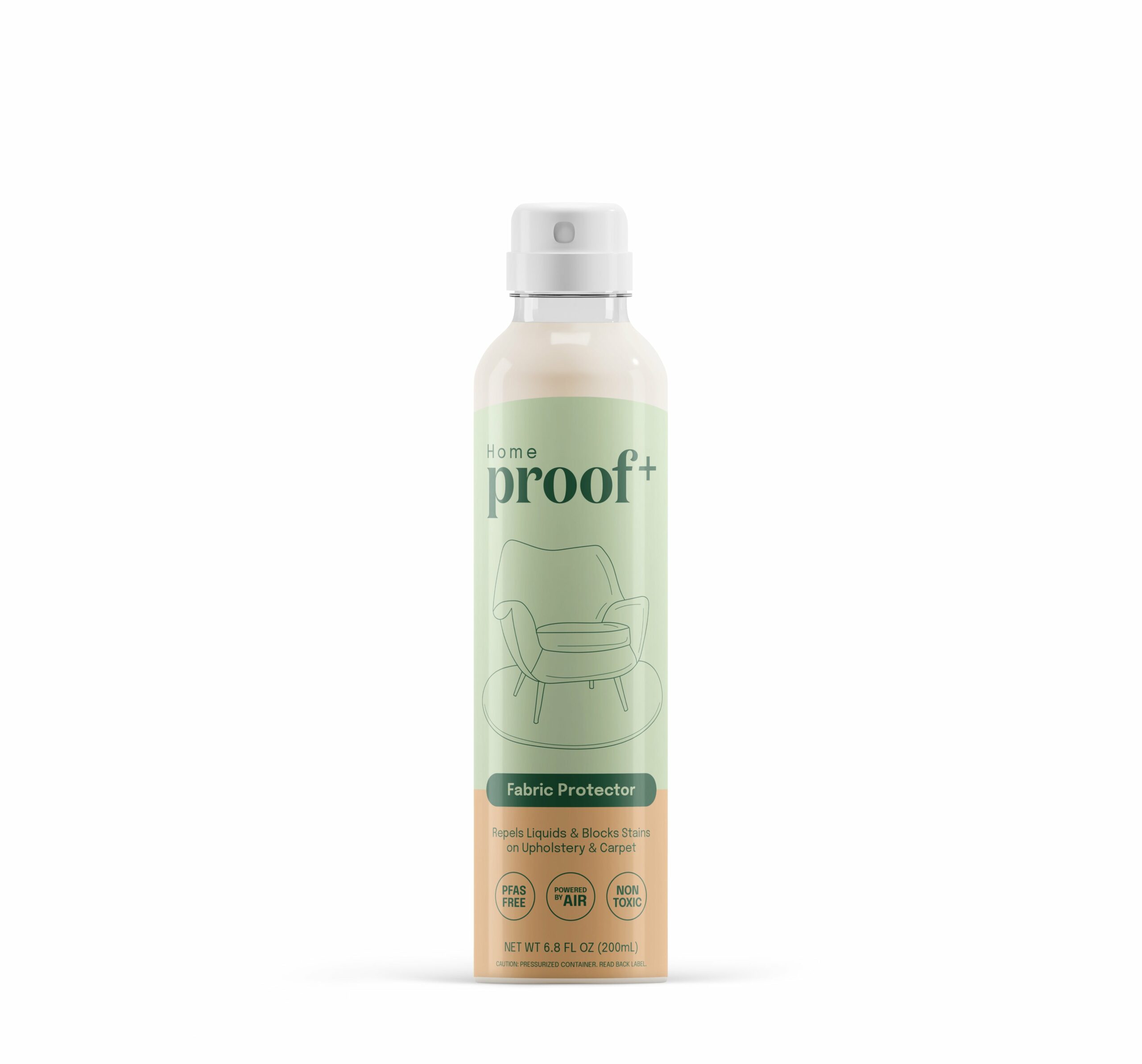
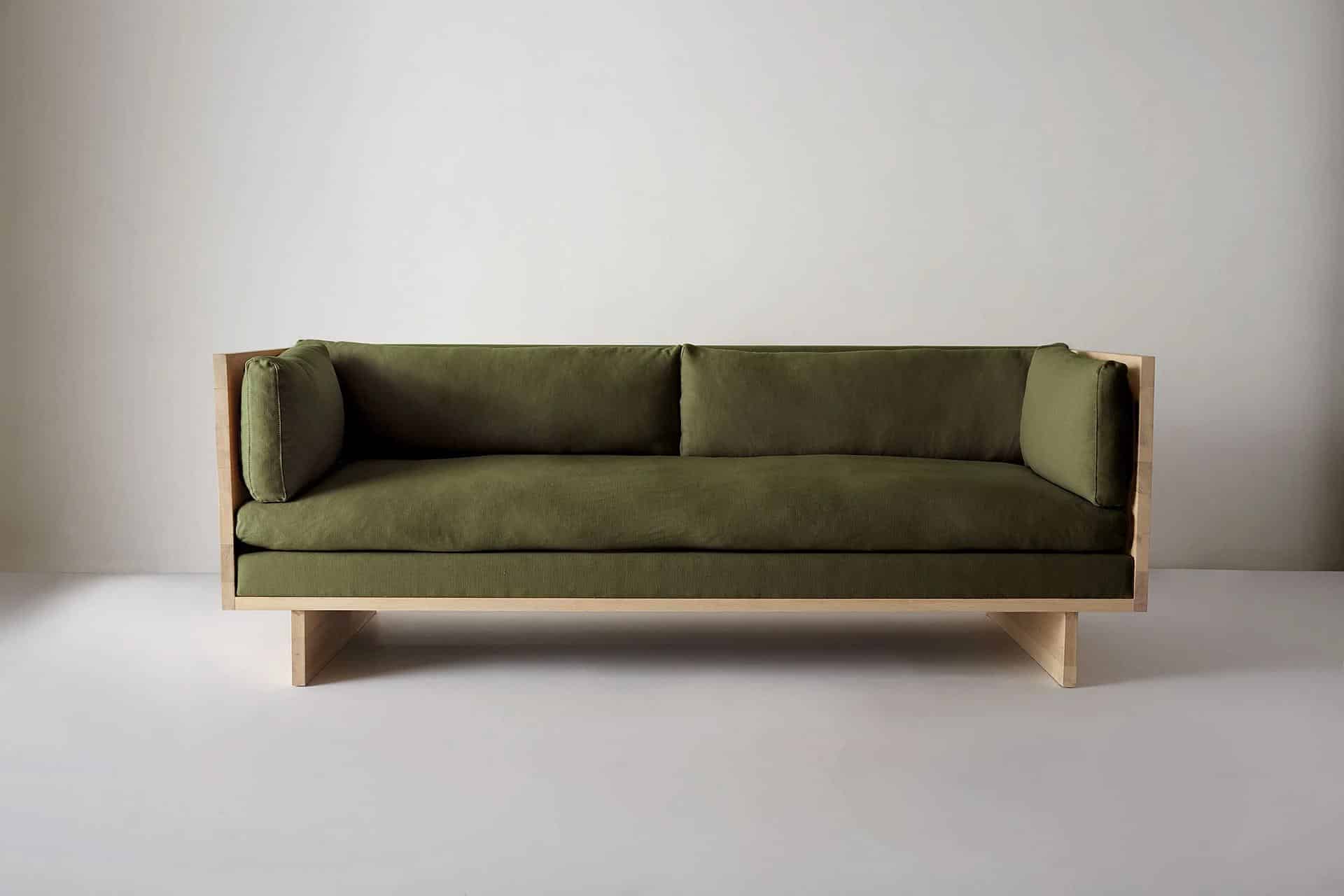
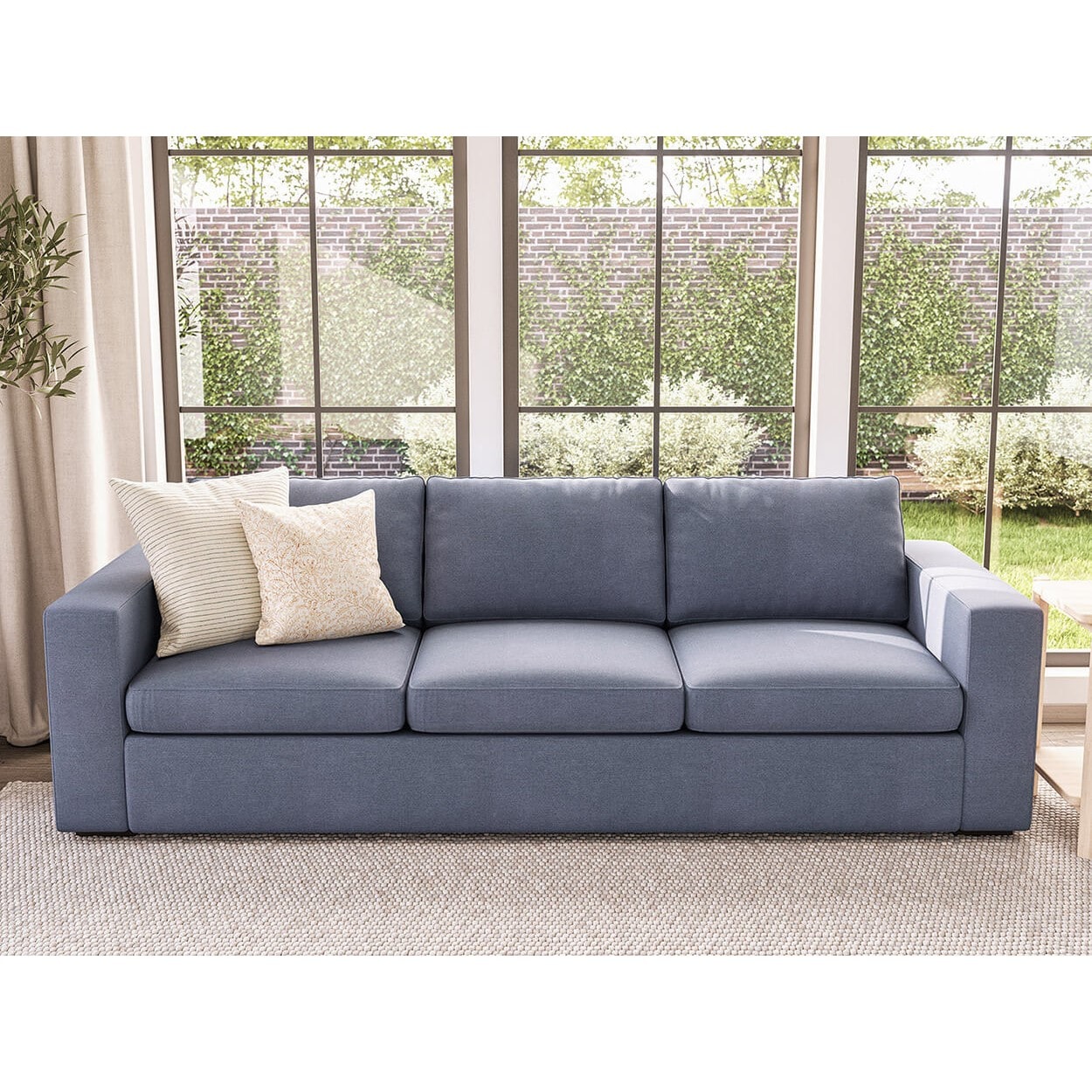
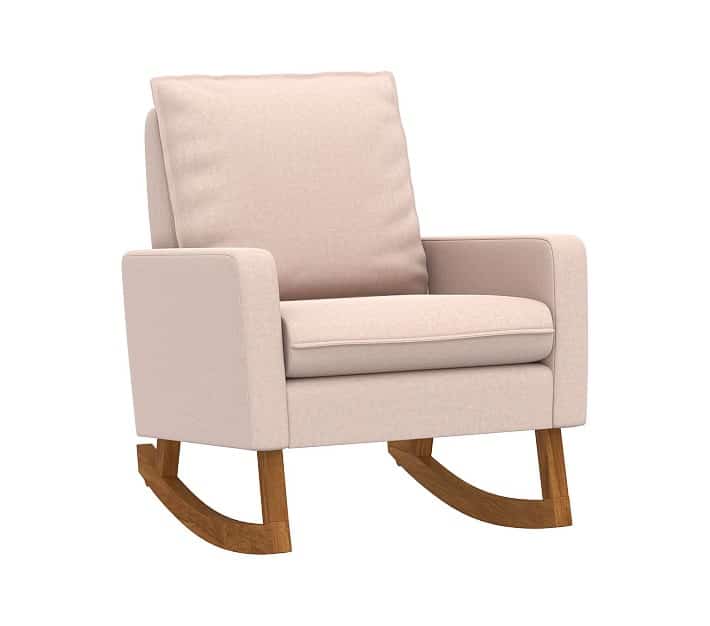
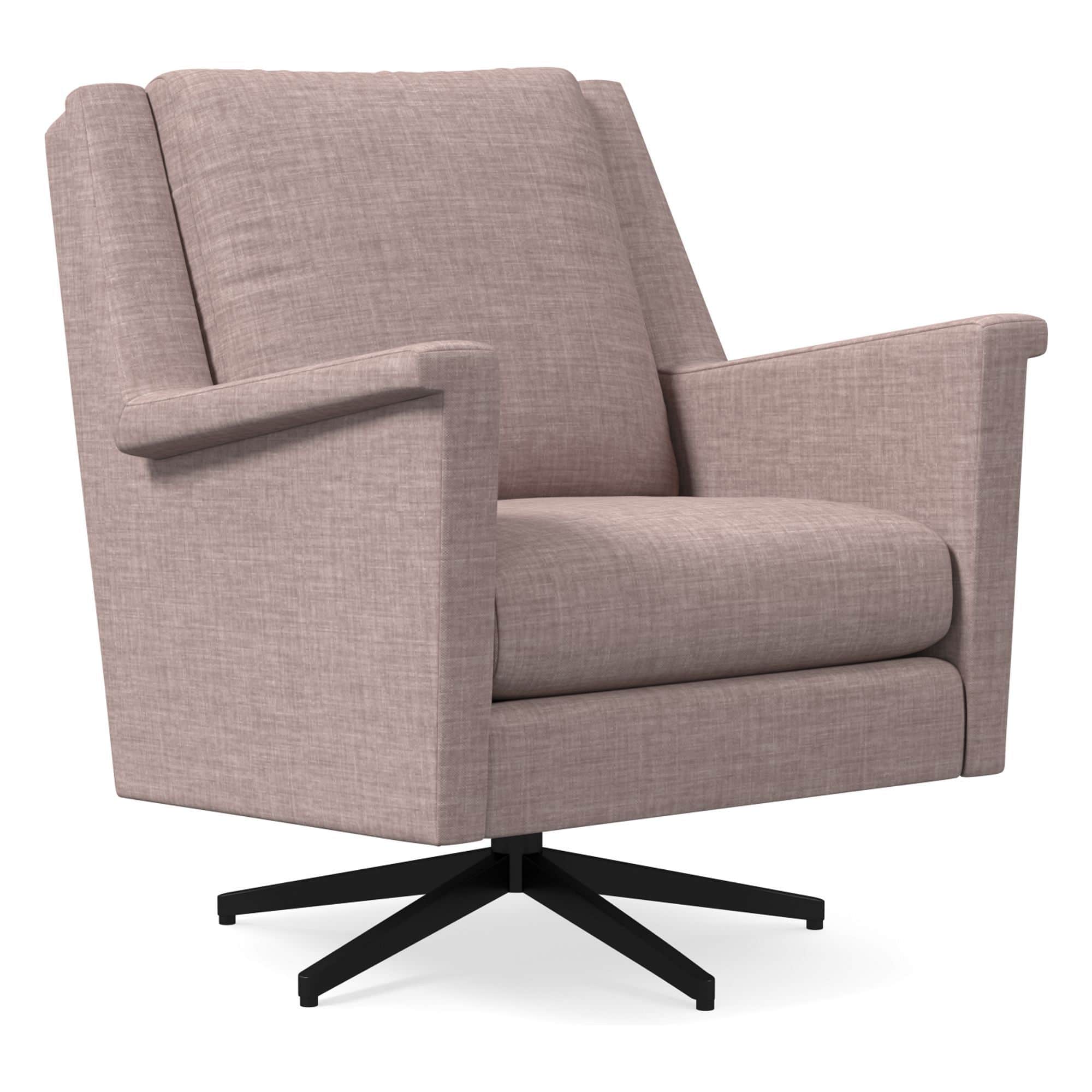

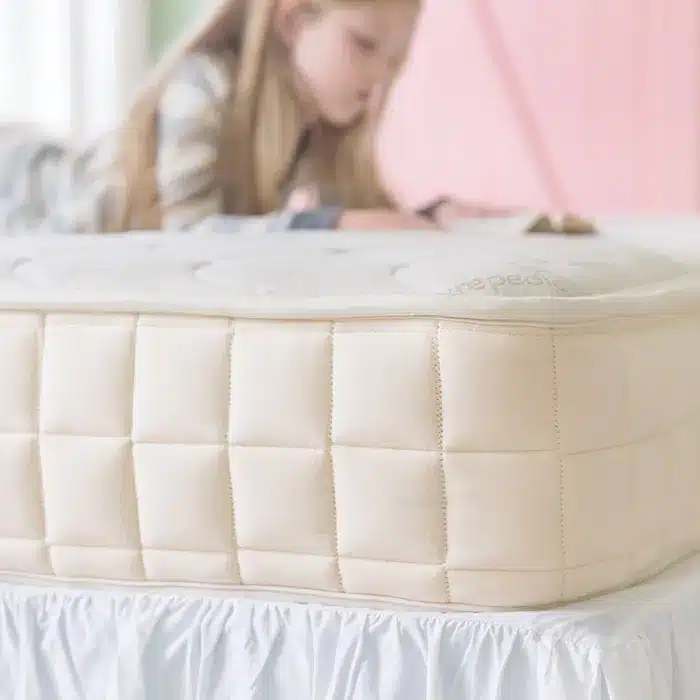
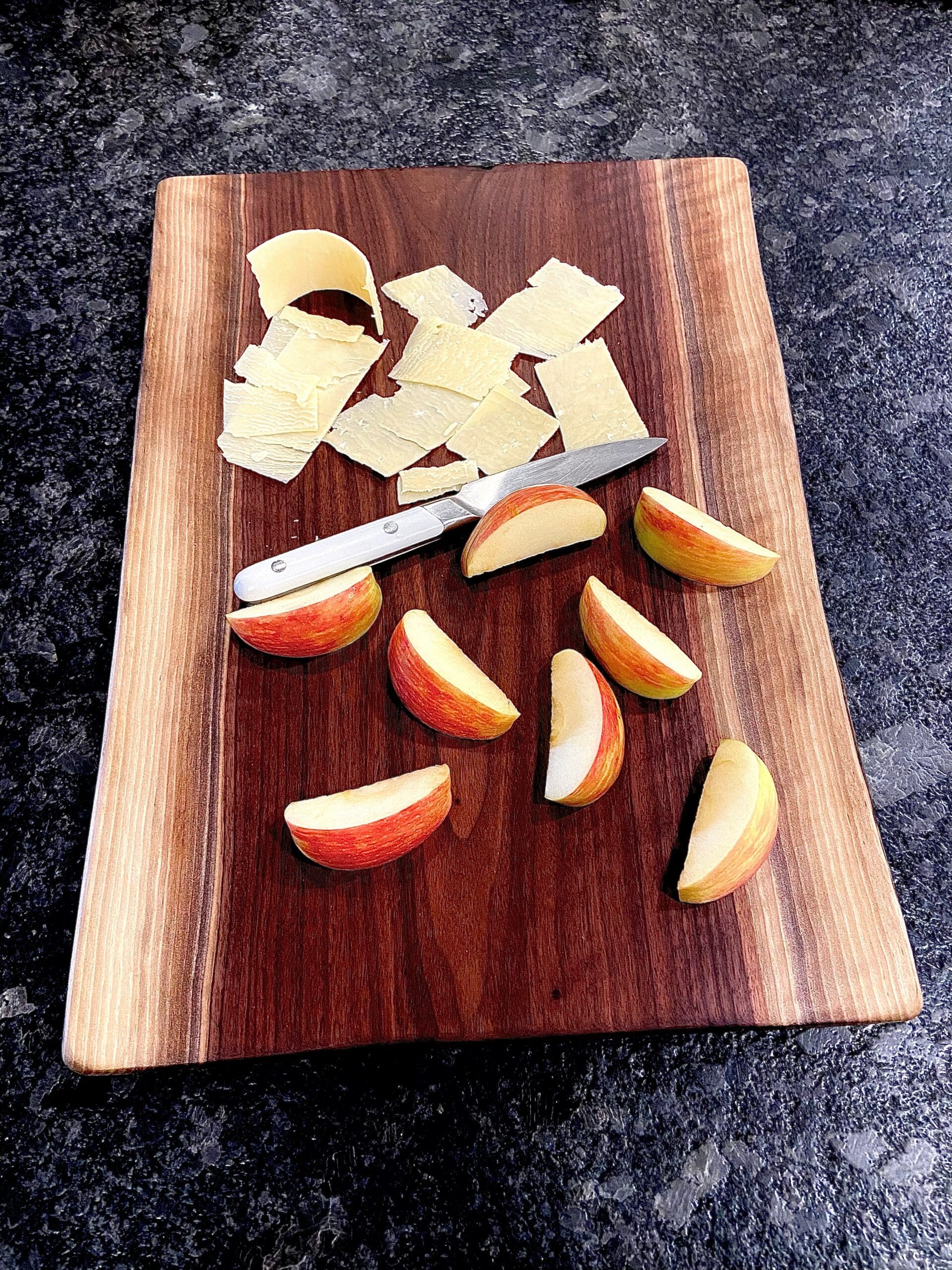
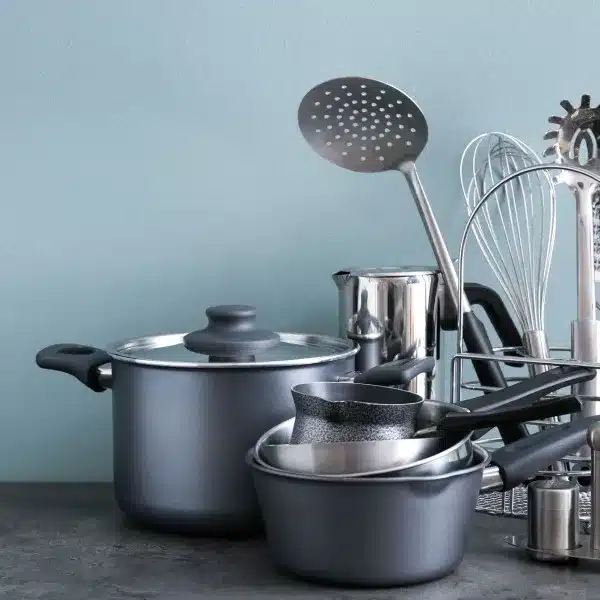
Leave a Reply
You must be logged in to post a comment.